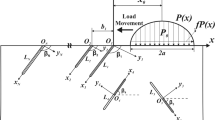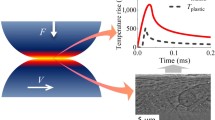Abstract
This paper theoretically investigates the effects of stick-slip in rolling contact zone on stress intensity factors (SIFs) for subsurface short cracks. New mathematical models for SIFs including stick-slip ratio are deduced in two cases. One is a subsurface short crack parallel to surface, and the numerical analysis shows that the value of K II increases with the increase of stick-slip ratio; the other is a subsurface short crack perpendicular to the surface, and the numerical analysis indicates that the positive value of K I decreases with the increase of stick-slip ratio. As ΔK I and ΔK II are necessary to evaluate the fatigue crack propagation rate or fatigue lifetime, the influences of stick-slip ratio on them are then discussed. It is found that the maximum variations of ΔK I and ΔK II are both around 3.0% due to stick-slip ratio variation.
Similar content being viewed by others
Abbreviations
- a :
-
Half of the width of contact zone
- a 1 :
-
Half of the width of stick zone
- c :
-
x-coordinate value of the crack
- \(\bar c\) :
-
c divided by a
- f :
-
Friction coefficient of rollers in contact
- h :
-
Depth of the crack
- \(\bar h\) :
-
h divided by a
- K I :
-
The model I stress intensity factor
- K Imax :
-
The maximal positive value of K I
- K DI :
-
K I for the lower crack tip
- K UI :
-
K I for the upper crack tip
- ΔK I :
-
Range of the stress intensity factor K I
- ΔK DI :
-
ΔK I for the lower crack tip
- ΔK UI :
-
ΔK I for the upper crack tip
- ΔK Imax :
-
The maximal value of ΔK I
- ΔK Imin :
-
The minimal value of ΔK I
- K II :
-
The mode II stress intensity factor
- ΔK II :
-
Range of the stress intensity factor K II
- ΔK IImax :
-
The maximal value of ΔK II
- ΔK IImin :
-
The minimal value of ΔK II
- L :
-
Length of the crack
- \(\bar L\) :
-
L divided by a
- m(z i , L):
-
Weight function
- p n :
-
Normal load per unit thickness
- p t :
-
Tangential load per unit thickness
- p z :
-
Normal force in contact zone
- p x :
-
Tangential force in contact zone
- s 1 :
-
Symbolic variable
- \(\bar x,\bar x_1 ,\bar x_2\) :
-
x-coordinates divided by a
- \(\bar z,\bar z_1 ,\bar z_2\) :
-
z-coordinates divided by a
- σ x :
-
Stress component in x-direction
- σ z :
-
Stress component in z-direction
- τ xz :
-
Shear stress
- τ c :
-
Net shear stress acted on crack faces
- σ s :
-
Material yield stress in shearing direction
- ξ :
-
Stick-slip ratio in contact zone
- η :
-
Friction coefficient of crack faces
- ψ I :
-
The maximum variation ratio of ΔK I
- ψ DI :
-
ψ I for the lower crack tip
- ψ UI :
-
ψ I for the upper crack tip
- ψ II :
-
The maximum variation ratio of ΔK II
References
Kalker J J. Three-dimensional Elastic Bodies in Rolling Contact. Dordrecht: Kluwer Academic Publishers, 1990. 40–62
Suresh S, Ritchie R O. Propagation of short fatigue cracks. Int Mater Rev, 1984, 29(1): 445–475
Carter F W. On the action of a locomotive driving wheel. Proc Royal Soc London A, 1926, 112: 151–157
Haines D J, Ollerton E. Contact stress distributions on elliptical contact surfaces subjected to radial and tangential forces. Proc Inst Mech Eng, 1963, 177(1): 95–114
Haines D J. Contact stresses in flat elliptical contact surfaces which support radial and shearing forces during rolling. Proc Inst Mech Eng, 1964, 179(10): 154–168
Lee A J C, Ollerton E. A photoelastic investigation of contact stresses in equal spheres rolling together with spin. J Strain Anal Eng, 1969, 4(3): 219–227
Johnson K L. The effect of a tangential contact force upon the rolling motion of an elastic sphere on a plane. J Appl Mech, 1958, 25: 339–346
Kaneta M, Murakami Y, Okazaki T. Growth mechanism of subsurface crack due to Hertzian contact. J Tribol, 1986, 108: 134–139
Keer L M, Bryant M D, Haritos G K. Subsurface and surface cracking due to Hertzian contact. J Lubr Technol, 1982, 104: 347–351
Keer L M, Bryant M D. A pitting model for rolling contact fatigue. J Lubr Technol, 1983, 105: 198–205
Murakami Y, Kaneta M, Yatsuzuka H. Analysis of surface crack propagation in lubricated rolling contact. ASLE Trans, 1985, 28(1): 60–68
Glodez S, Ren Z. Modelling of crack growth under cyclic contact loading. Theor Appl Fract Mec, 1998, 30: 159–173
Ren Z, Glodez S, Fajdiga G, et al. Surface initiated crack growth simulation in moving lubricated contact. Theor Appl Fract Mec, 2002, 38: 141–149
Hu Y D, Hu Z Z, Cao S Z. Theoretical study on Manson-Coffin equation for physically short cracks and lifetime prediction. Sci China Tech Sci, 2012, 55(1): 34–42
Peng D, Jones R, Constable T, et al. The tool for assessing the damage tolerance of railway wheel under service conditions. Theor Appl Fract Mec, 2012, 57: 1–13
Peng D, Jones R. The development of combination mechanical contact and thermal braking loads for railway wheel fatigue analysis. Theor Appl Fract Mec, 2012, 60(1): 10–14
Guan M F, Yu H. In-situ investigation on the fatigue crack propagation behavior in ferrite-pearlite and dual-phase ferrite-bainite low carbon steels. Sci China Tech Sci, 2013, 56(1):71–79
Hearle A D, Johnson K L. Mode II stress intensity factor for a crack parallel to the surface of an elastic half-space subjected to a moving point load. J Mech Phys Solids, 1985, 33(1): 61–81
Sheppard S, Barber J R, Comninou M. Short subsurface cracks under conditions of slip and stick caused by a moving compressive load. J Appl Mech, 1985, 52: 811–817
Liu J T, Du P A, Zhang Z Y. A general model of fatigue crack growth under variable amplitude loading. Sci China Tech Sci, 2012, 55(3): 673–683
Ringsberg J W, Bergkvist A. On Propagation of short rolling contact fatigue cracks. Fatigue Fract Engng Mater Struct, 2003, 26(10): 969–983
Kong X A, Jiang X Y. Solid Contact Mechanics (in Chinese). Beijing: China Railway Press, 1999. 28–29
Shang D G, Yao W X, Wang D J. A new approach to the determination of fatigue crack initiation size. Int J Fatigue, 1998, 20(9): 683–687
Miller K J. The short crack problem. Fatigue Fract Engng Mater Struct, 1982, 5(3): 223–232
Parker A P. Stress intensity factors, crack profiles, and fatigue crack growth rates in residual stress fields. In: Throop J F, Reemsnyder H S, eds. Residual Stress Effects in Fatigue. ASTM, STP, Phoenix, Ariz., 1982. 13–31
Author information
Authors and Affiliations
Corresponding author
Rights and permissions
About this article
Cite this article
Liu, W., Zhang, Y., Feng, Z. et al. Effects of stick-slip on stress intensity factors for subsurface short cracks in rolling contact. Sci. China Technol. Sci. 56, 2413–2421 (2013). https://doi.org/10.1007/s11431-013-5307-1
Received:
Accepted:
Published:
Issue Date:
DOI: https://doi.org/10.1007/s11431-013-5307-1




